For the first 10 minutes of Resident Evil 4, there’s scarcely an enemy.. Instead, the emphasis is on the Spanish countryside — a dim, damp, grey, crushing sadness. Crows fly low to the ground. A dog whimpers in pain, his front leg caught in an iron trap. It’s quiet — almost unsettlingly so.
And, yes, there are several villagers that lumber towards you, but they’re little threat. The silence creates a slow-burning tension, emphasising mood over action. And we wouldn’t want it any other way. In a game filled with incredible levels, Resident Evil 4‘s village level stood tallest. Other levels might have had stronger enemies or more varied structure, but it was in the village that you felt most vulnerable. Never again did you feel so helpless, and so hopelessly outmatched.
Resident Evil 4 is an unqualified classic, a different breed than every Resident Evil game that came before it. Prior games had claustrophobic architecture, with blind corners, varied camera angles, and long hallways.
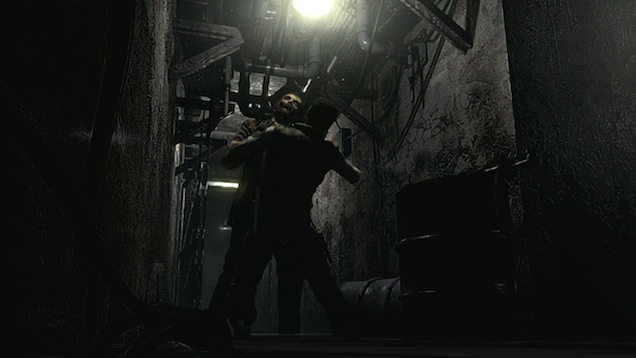
In Resident Evil 4, the developers opted for a tracking, over-the-shoulder setup, and they replaced the tight corridors with wide, open spaces. When fans first heard about the change, they derided it as regressive. What Resident Evil 4 lost in cinematic style, however, it gained in more naturalistic, personal play.
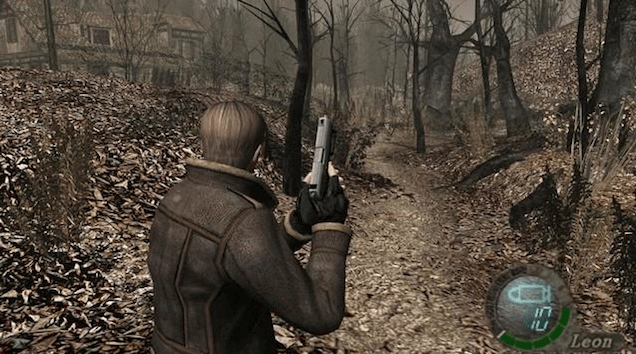
Take the music, for example. In past Resident Evil games, music meant that the coast was clear. It was when you heard silence that you knew the infected would attack. Resident Evil 4 inverted this formula — music would play when the action started up, and would fade when the last enemy’s head exploded. You spent the majority of the game hearing natural, diegetic sound. You came to relish the natural silence; you could catch your breath, appreciate your beautifully-rendered surroundings, and search for ammo in peace in preparation for the next battle.
The game opened with a classic red herring. You were driven to the outskirts of the local Spanish village, and your driver (and his buddy) acted very suspiciously. They whispered and mumbled detached, creepy things. You were there retrieve the President’s daughter, and so your first thought was probably, “These guys must be in on it.” But then a random villager attacked you, and your driver hightailed it out of there. Well. Guess not.
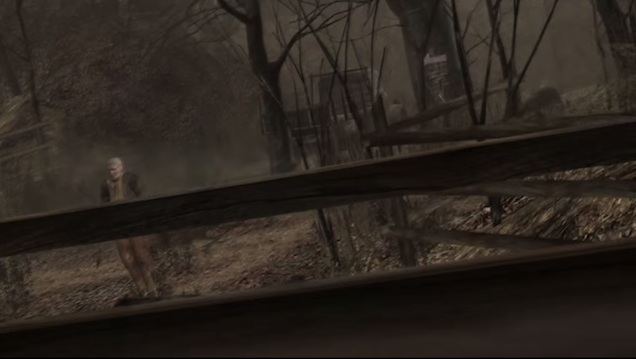
At this point, you had to shoot some villagers. But ironically, instead of making you feel stronger, your firearm made you vulnerable in other ways. Whenever you aimed, the game planted your feet; you could not move, and thus, you could not ‘run and gun.’ Your speed — your number one advantage against the plodding villagers — was neutralized.
You were forced to stand your ground, and this made for a more suspenseful, immediate experience. To complicate matters, every weapon forced you through stationary, protracted reload animations. Getting down to the last bullet in your chamber was dangerous, because if you stopped to reload, it would take at least three seconds of anxiety-inducing animation. You would be anchored to the floor, enemies surrounding you, and you would be dead. Again.
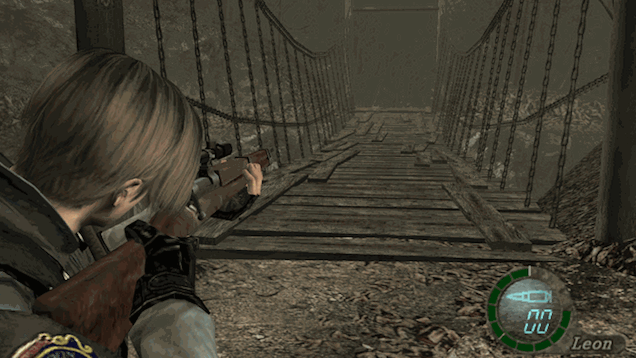
When you reached the village’s town square, ready for war, the game prolonged the suspense, and tortured you for a second longer. For the first and only time in the game, Leon took out his trusty binoculars. You could look around, zoom in, and zoom out on the village square. You saw your driver, spiked through the chest, burning on a large bonfire.
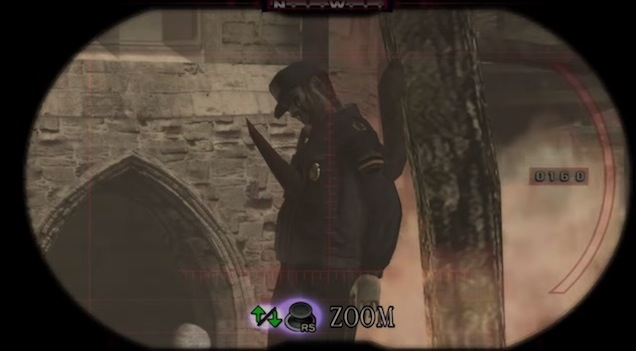
Good. God. That couldn’t possibly mean anything good.
Everything in this village looked disgusting — like there was a thin layer of grime that crusted over every surface. Buildings and objects were falling apart, but they were not broken — they were rotting from disuse. Everyone’s skin looked greasy, their hair unkempt. This was well-earned filth, the result of neglect over a long period of time rather than a single, catastrophic disaster. This was not a T-Virus ‘epidemic.’ Leon was stepping into an intractable situation where the sickness, whatever it was, had taken root and flourished.
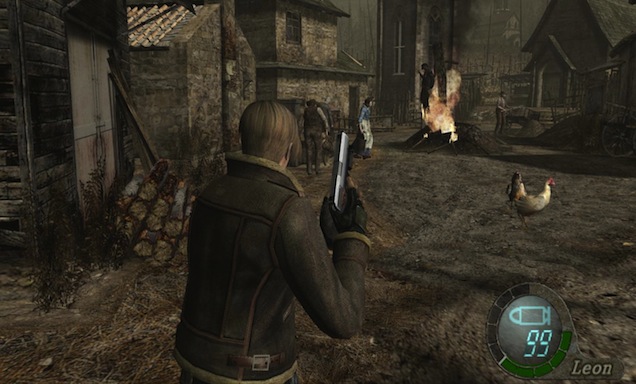
The villagers could still speak and communicate with one another. They were still carting supplies, and baling hay, and tending fires, albeit slowly. They were going through the motions of their former lives. They hadn’t yet abandoned all of their humanity and, ironically, this made them worse. T-Virus victims were rendered brainless and, thus, blameless — animals who communicated in moans and growls and who didn’t know any better. The villagers, by contrast, appeared more complicit in their misdeeds.
Stealth here was not an option. Sure, you could sneak around for a bit, but you wouldn’t be able to advance in the plot that way. So, by design, you had no choice but to run in, loudly and stupidly, and take on the entire village. By yourself. Armed with nothing but one handgun and a few clips.
I first tried fighting the villagers head on, out in the town square. Eventually, I ran out of bullets, I wasted my one grenade (did you know that crows drop grenades when you kill them?), and I had nothing left but my knife. One measly knife against sickles, hatchets, and pitchforks? Impossible. The first time I took on the entire village with my knife, a creepy, pale woman snuck up behind me and choked me out. On the next attempt, a group of ten villagers backed me up against a wall, catching me in the head with a flying hatchet. So I tried again, and died again. Repeatedly. It was a brutal but instructive practice in trial and error.
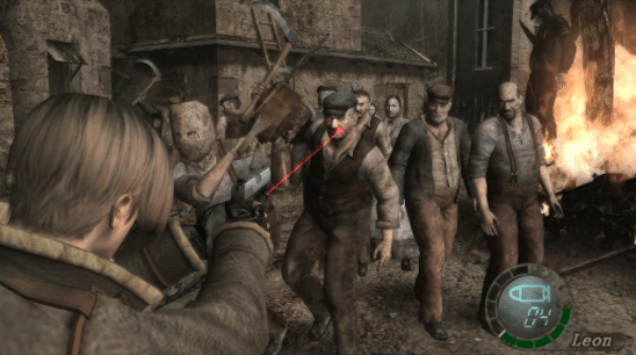
These enemies were hard to kill. In most games, it took several bullets to the center of mass to kill an enemy. In Resident Evil 4, I found myself expending round after round on single villagers. Even if you scored a headshot, there was no guarantee of an insta-kill.
The only way to win an open fight with the villagers was to kneecap them with a single bullet. And then, while they were stunned or lying on the ground, you could either knife them to death, or deliver a powerful spinning kick. Effective, yes, but when we first started playing, most of us probably lacked the dexterity and patience to do this, never mind the foresight to conserve enough ammo.
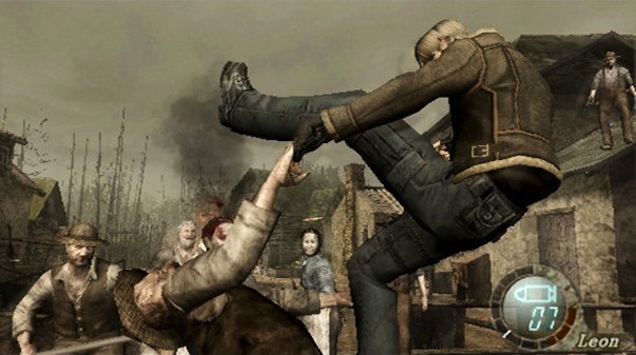
So, eventually, after dying six or seven times, you tried to hide and fortify yourself. And if you jumped over the fence and headed into the first house on the left, it triggered a dramatic cut scene. The villagers rallied more men, set up a ladder to the second floor, and began pouring themselves in. You also had a crazy maniac with a chainsaw to deal with — more on him later.
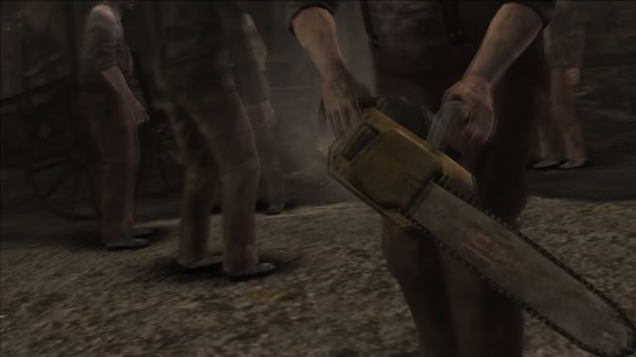
You could spend some precious time pushing a dresser in front of a window to block them off, but the amount of good this did was negligible. Those villagers were coming in, one way or another — you could see the doors rattling and the windows breaking as they pushed their way through. You could head deeper into the first floor, and fortify yourself under the stairs, but it was never a good idea to fight with your back to the wall. Your best and only option was to run up the stairs and seek higher ground.
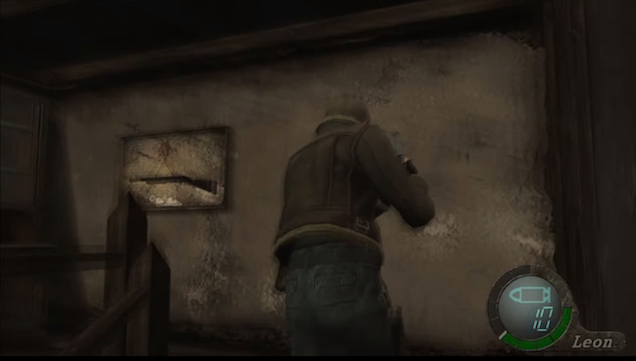
On the top floor, mounted on the stair landing, was your salvation: a pump action shotgun with a wide spread that could destroy multiple villagers in a single shot. In front of you, there was a glass cabinet housing a grenade. And, lastly, on the bed to your left was a case of shotgun ammo.
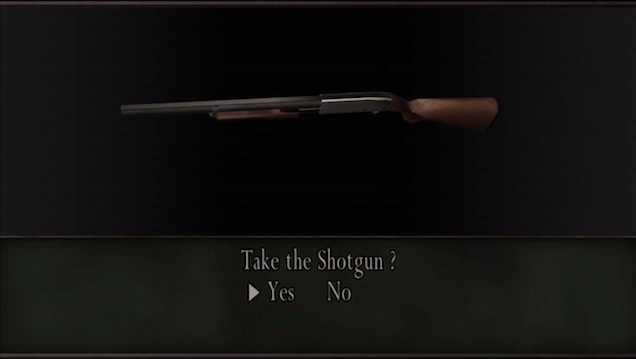
It wasn’t much, but it was enough. You now had enough ammo to complete the fight sequence — although not enough to leave the village feeling well-stocked or powerful. It was this constant feeling of inadequacy — the lack of an extra clip, a spare grenade, one more herb — that set a player’s teeth on edge. There were no true ‘shock scares’ in Resident Evil 4. It was more of an abstract dread — of always feeling weak and outmatched in every situation.
Wielding that shotgun was the closest that Leon ever came to feeling powerful. Its stopping power was the only way an average player could beat the chainsaw maniac (his name was Dr. Salvador, although that was never mentioned in the main storyline). Leon’s handgun, by contrast, provided no stopping power at all — our good friend Salvador would charge right through your bullets and, if he got to you, it was a one-hit kill.
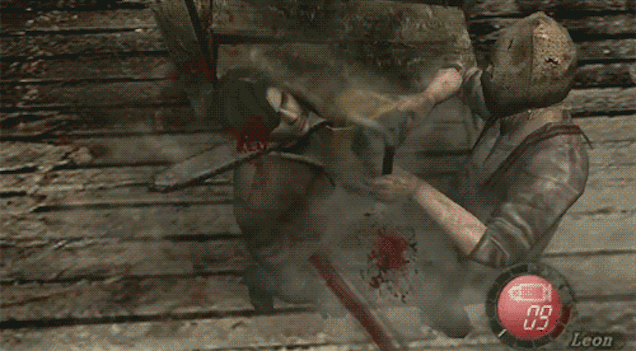
Salvador excelled in close quarters, and so you now had a new priority: get out of the house as quickly as possible. The top floor was way too cramped, and left you little room to manoeuvre around. And although they were dumb, the villagers had their brief moments of insight. For example, even though you could push the ladder down, to prevent more villagers from coming in:
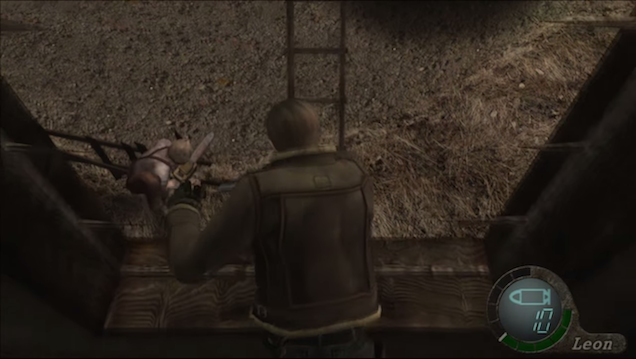
They would eventually prop the ladder back up, and continue their assault.
You were better off climbing up and onto the roof. From that high-ground position, it was more difficult to be surrounded. By sniping from the roof, you may have also discovered a neat gameplay mechanic — with a well-timed shot, you could knock the villagers’ weapons out of the air, mid-flight, or out of their hands. This made a satisfying, metallic *ping* sound whenever you succeeded, and it made your enemies feel more real. They were ‘armed’ — their weapons were not crude extensions of their bodies.
The roof was safest, but in order to loot the greatest amount of gold and ammo, you had to fight the villagers on the ground. And now that that you had the shotgun, fighting out in the open with no fortifications was a bit easier.
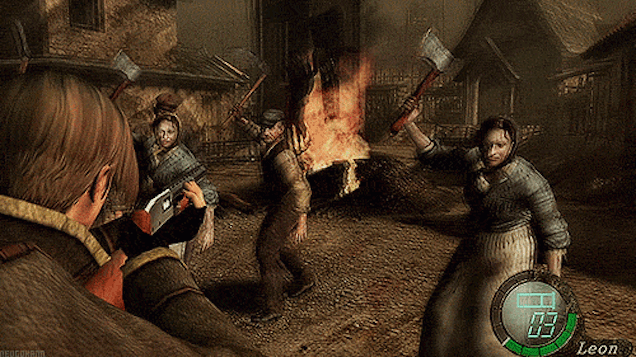
But you only got a handful of shotgun rounds, so it was crucial to switch between weapons. The handgun worked for the regular villagers, but the shotgun was for Salvador — or for a mob of villagers that got too overwhelming. Resident Evil 4 managed to passively instruct you on inventory management without holding your hand through some didactic teaching session. That kind of trial by fire was much more exciting, if not humbling.
But even when you ‘won,’ it was demoralizing. The church bell rang, and the villagers walked away from you, as though in a trance. Suddenly, you didn’t matter much.
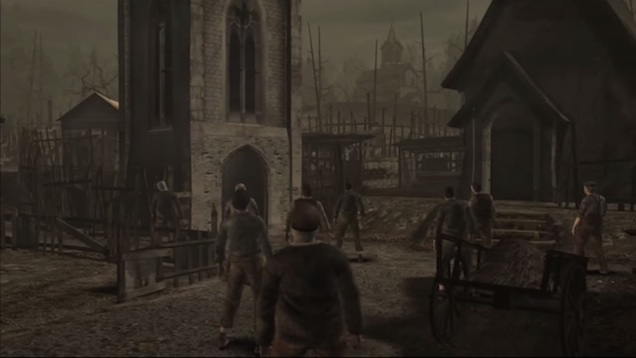
It reminded me of the Borg in Star Trek: The Next Generation. When Riker and his away team beamed over to the Borg cube, the drones completely ignored them. The Borg were confident, so secure in their power, that even when Starfleet was inside their ship, the Borg considered them to be no threat at all.
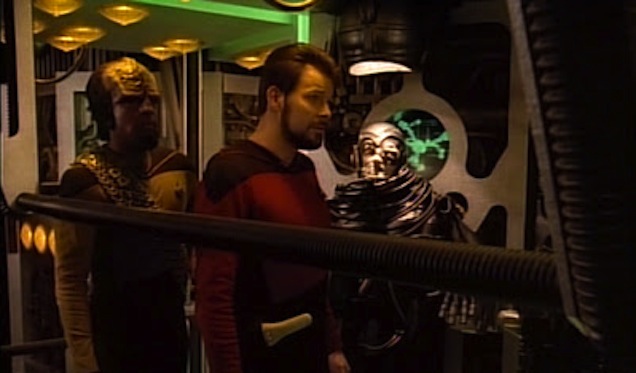
The conclusion of the village fight was relieving, but passively insulting — to have tried so hard, and ultimately to have mattered so little. There was no climactic victory, no boss or final, badass move. Instead, the game ‘permitted’ you to live; without the bell, you would eventually be killed, in a protracted war of attrition. Of course, that wasn’t reality — your kill count, rather than elapsed time, triggered the cut scene. But it didn’t feel that way. It felt like you barely escaped with your life.
The Resident Evil series has always portrayed its heroes as ‘in over their heads’ — never asking for trouble, and always thrust into horrible situations that only got worse. It was only in the last two main games — Resident Evil 5 particularly — that our protagonists felt strong, carrying military-grade weapons and truckloads of ammo. But Resident Evil 4 remains the glorious apex of the series — it split the difference between the more recent titles and the older, ‘classic’ games. Resident Evil 4 had the clear, linear objectives of an action title along with the unscripted, spontaneous combat that survival horror thrives on. Only The Last of Us managed a similar, perfect balance of action and atmosphere.
Too often, opening levels in video games feel detached from what comes afterwards. They are glorified, pedantic tutorials — we are babied and unchallenged for the first thirty minutes of a game, or more. Resident Evil 4 did the exact the opposite. The developers dumped us into a challenging sequence with little ammo, and told us to figure it out. It was a brilliant tactic — one that works particularly well in the horror genre, which aims to make its audience feel vulnerable and unsafe at all times.
In a way, the developers mirrored our gaming experience to Leon’s state of mind — just like our avatar, we were forced to react, improvise, and fumble our way through an unexpected situation.
Kevin is an AP English Language teacher and freelance writer from Queens, NY. His focus is on video games, American pop culture, and Asian American issues. He wrote a weekly column for Complex called “Throwback Thursdays,” which spotlighted video games and trends from previous console generations. Kevin has also been published in VIBE, Salon, PopMatters and Racialicious, and he will soon be published in Joystiq. You can email him at kevinjameswong@gmail.com.
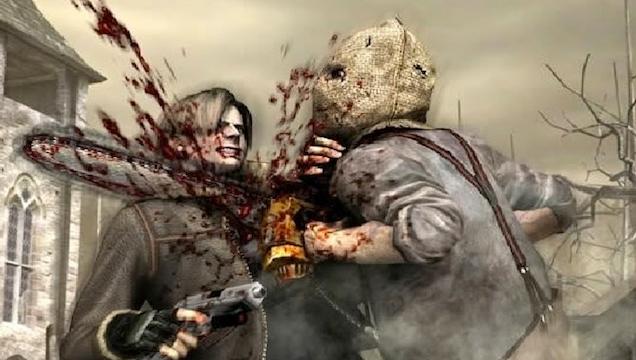
Comments
17 responses to “The Cruel Brilliance Of Resident Evil 4’s Village Fight”
It’s always good to see more pieces on how brilliant this game is! It may be widely well-regarded, but it still never seems to earn the full recognition of it’s accomplishments. Perhaps mixed feelings on later instalments have unfairly soured it? It’s true that they weren’t as solid, and though I found a lot to enjoy in RE5 and RE6, it’s a very different flavour of fun. It would be great to see something new come along, that captures the balance of action and tension as well as RE4.
http://www.digra.org/wp-content/uploads/digital-library/09287.24171.pdf
For an academic look at RE4
God this makes me want to finish it. I almost finished it on GameCube but got stuck and when I downloaded the hd remake I still never finished it.
That level had me rage quit so many times. Then I finally passed it…….and I was hooked.
From the very first time I played this game (but not the first attempt), I stumbled on a way to make this area of the game a lot more manageable. I ran back to the gate from which I came through from the previous area, which funneled into a narrow path and by which no enemies managed to spawn behind me (if I remained close enough to the gate itself). Then all I had to do was wait for the enemies to come funneling in where I could either throw the one grenade that I had at this point (when their numbers became too large), or just kneecap the closest villager and round house kick them whilst wiping out several more at the same time (rinse and repeat). Doing it this way also stopped the chainsaw guy from spawning in the map as well. I know this seems like the easy way out, but it saves a lot of heartache (especially on the hardest difficulty).
I always find that the cabin just past that large bridge (and just before the split path decision) is more difficult than the village, although I entirely understand the point being made in this article – that it’s your first taste of chaos in the game after it mostly being quiet up until that point, which for a newcomer makes it all the more harrowing. Actually, now that I think about it, there are quite a few areas that can become quickly overwhelming unless some quick thinking takes place (or unless you figure out a cheap way out to handle the situation like I mentioned above).
But in saying all that, this was a really good article, Kevin! It makes we want to go and play the more recent HD release of this game on PC again, which at 60 frames per second seems far more playable than the 30 frames per second on all the releases before it (although that is only looking at it retrospectively, as the original Gamecube release was simply amazing at the time). It also makes you realise how well thought out the game was, and how certain mechanics (if implemented correctly) can turn a good game into an excellent one (with a much longer lasting appeal).
If you don’t kill the chainsaw guy, you miss his awesome loot. There was also second one at the gate to the next area if you got there before the bell.
Have you played the Wii release? I thought it wouldn’t be too good but found aiming heaps better and the added PS2 sections were welcome. PC would probably win out with mouse aiming though. Never played that version.
Yeah, that’s a fair point. I’m pretty methodical and thorough when it comes to collecting loot and items in games like this. I think it’s more to do with not really having much in the way of firepower at that early stage (like how this article mentions the first time pickup of the shotgun in that house with limited ammo – I wouldn’t take on the chainsaw guy without it, especially on the hardest difficulty setting which I like to play for a challenge). Other than that opening fight in the village, I’m pretty slow moving to make sure I don’t miss anything 😛
I never did try the Wii release of Resident Evil 4 (although I heard good things about it). I didn’t play with a keyboard an mouse on the Ultimate HD version of the game on PC; I use an Xbox 360 controller mostly for games that are 3rd person perspective (even though it’s really close and over the shoulder). I definitely recommend the Ultimate HD version since it got patched (had some bugs and graphical glitches to begin with, but have since been ironed out).
Bought a GameCube just for this game after reading reviews back in 05. Money well spent, genius game. Represented all round great value and it pisses all over RE games since. Only RE1 had the same gloom factor.
I dunno, that part with the “Right Hand” guy chasing you around while you waited for the elevator to come up did a pretty good job of that too.
You could actually kill that guy! Took ages though. If I recall you could freeze him with some sort of gas tanks and get in lots of damage.
Haha yeah, one of my friends had absolutely no idea you could. We were playing through it together as a group and he let out some exclamations of shock when I killed him. Totally essential though, otherwise you couldn’t complete the crown and trade it in for maximum cash.
Ding ding ding – this man knows what he’s doing!
This was a really great read! I’d love to see more retrospectives like this in future 🙂
I Remember shooting the item vendor the second or third time he appeared, that was very inconvenient
Did that stop him from ever showing up again in future locations?
he appeared in the next location, but being able to kill him at all was not something that should have been allowed
When it came out it was mentioned as a positive as in “if you kill him he won’t come back so be careful” etc. Consequences and stuff!